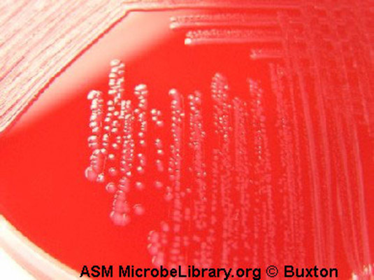15.1.2.2.3: Enterococcus
- Page ID
- 42660
\( \newcommand{\vecs}[1]{\overset { \scriptstyle \rightharpoonup} {\mathbf{#1}} } \) \( \newcommand{\vecd}[1]{\overset{-\!-\!\rightharpoonup}{\vphantom{a}\smash {#1}}} \)\(\newcommand{\id}{\mathrm{id}}\) \( \newcommand{\Span}{\mathrm{span}}\) \( \newcommand{\kernel}{\mathrm{null}\,}\) \( \newcommand{\range}{\mathrm{range}\,}\) \( \newcommand{\RealPart}{\mathrm{Re}}\) \( \newcommand{\ImaginaryPart}{\mathrm{Im}}\) \( \newcommand{\Argument}{\mathrm{Arg}}\) \( \newcommand{\norm}[1]{\| #1 \|}\) \( \newcommand{\inner}[2]{\langle #1, #2 \rangle}\) \( \newcommand{\Span}{\mathrm{span}}\) \(\newcommand{\id}{\mathrm{id}}\) \( \newcommand{\Span}{\mathrm{span}}\) \( \newcommand{\kernel}{\mathrm{null}\,}\) \( \newcommand{\range}{\mathrm{range}\,}\) \( \newcommand{\RealPart}{\mathrm{Re}}\) \( \newcommand{\ImaginaryPart}{\mathrm{Im}}\) \( \newcommand{\Argument}{\mathrm{Arg}}\) \( \newcommand{\norm}[1]{\| #1 \|}\) \( \newcommand{\inner}[2]{\langle #1, #2 \rangle}\) \( \newcommand{\Span}{\mathrm{span}}\)\(\newcommand{\AA}{\unicode[.8,0]{x212B}}\)

Organism
- Enterococci are Gram-positive cocci that grow in pairs or short chains
- No capsule
- Catalase negative
- Gamma-hemolytic
- Facultative anaerobe
- Can be differentiated from Streptococcus by growth in 6.5% salt
- Clinically relevant species are E. faecium and E. faecalis

Habitat
- Normal gut flora
Source
- Introduced into other areas of the body (lungs, urinary tract, bloodstream, etc.) through bad hygiene
Epidemiology
- Cause about 10% of nosocomial infections
- Typically affect older adults, immunocompromised, and hospitalized
Clinical Disease
- Can cause a variety of infections including:
- urinary tract infection
- bacteremia (bacteria in the blood)
- endocarditis
- wound infections
- Treatment can be difficult due to prevalence of highly antibiotic-resistant strains such as vancomycin-resistant Enterococcus (VRE)
- resistance genes often found on plasmids
- considered serious threat by the CDC
- About 10% fatal
- It is imperative that health care workers take precautions when caring for patients such as hand washing, wearing gloves, proper antisepsis and cleansing of patient wounds, and good aseptic technique when inserting in-dwelling devices.
Primary Virulence Factors
- Opportunistic pathogen
- No notable virulence factors other than the ability to grow in the human body
Additional Information: CDC fact sheet

